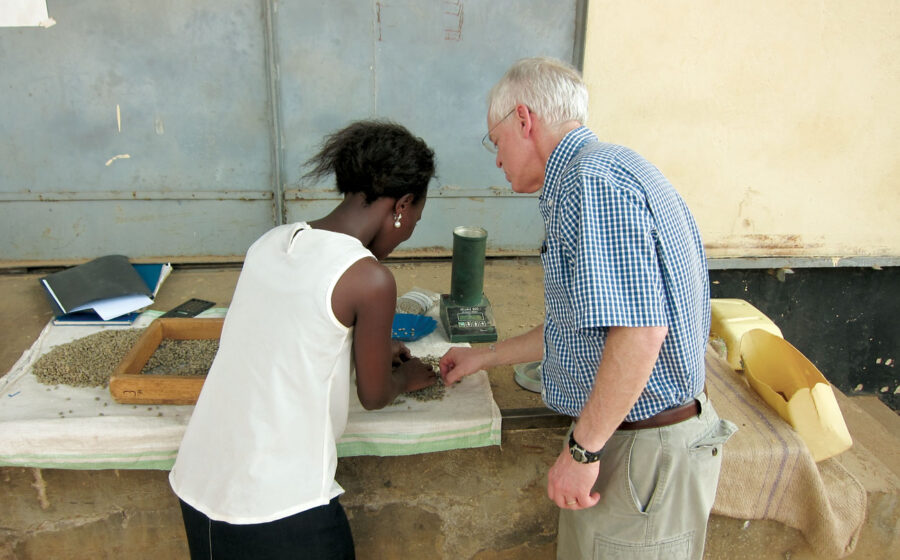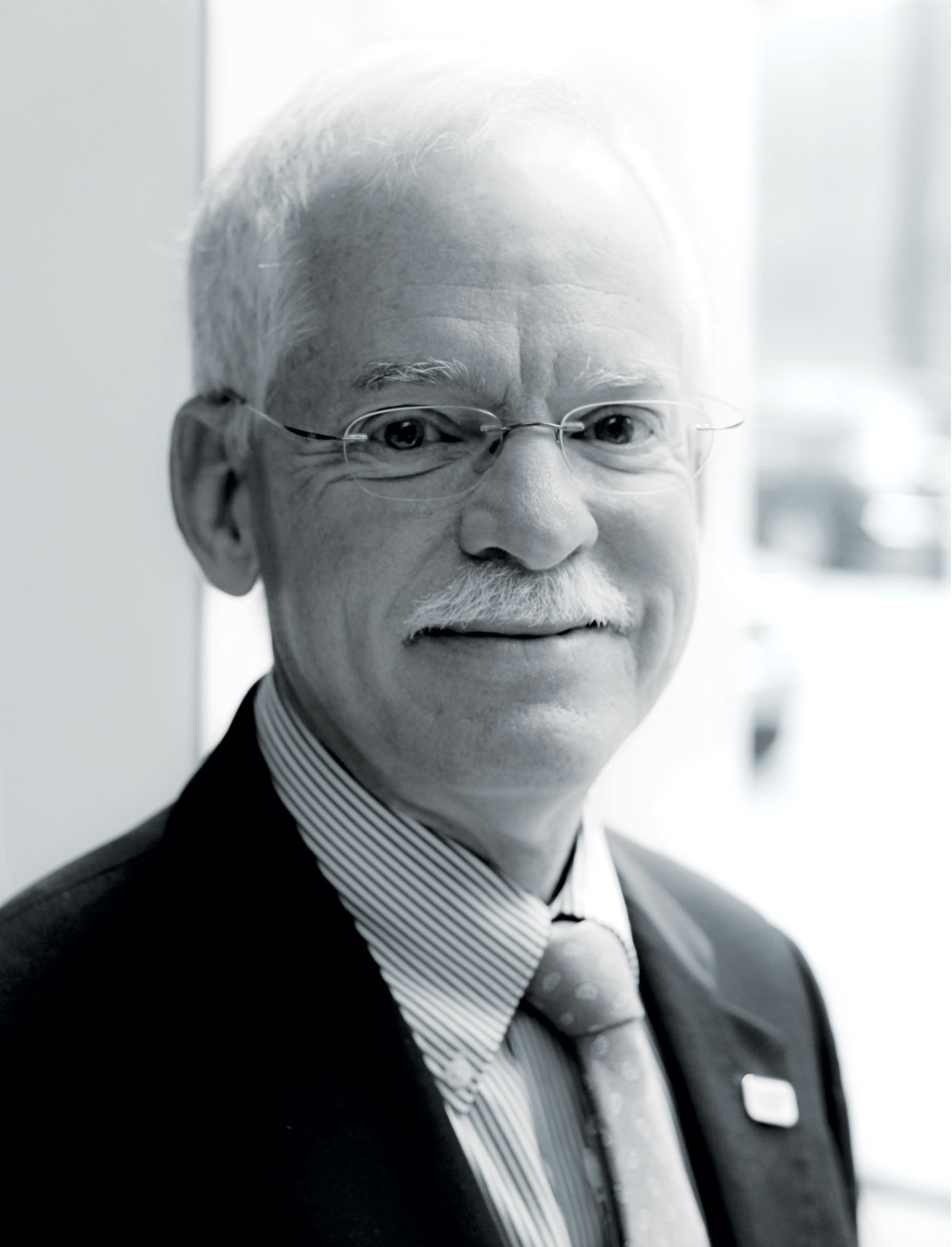[W]hen Rick Peyser walked to the lectern at Let’s Talk Coffee in Panama last October, it was the first time most of the audience had seen him since he had left Keurig Green Mountain. During more than a quarter century at the company, Peyser had become one of the industry’s great champions of smallholders and the workers who reside at the start of the coffee supply chain. Though he insisted he wasn’t retired, plenty of attendees at the show worried a major advocate, positioned at an influential company, had bowed out.
This wasn’t limited to those from consumer countries. During Sustainable Harvest’s award ceremony that weekend, a producer broke into tears as he thanked Peyser for the help he’d given the farmer and his community. What few, if any, of the participants knew was that he was already headed to his next project.
Less than a month after Peyser left Keurig Green Mountain, the CEO of Lutheran World Relief, Daniel Speckhard, contacted him and offered a job in the new position of senior relationship manager for coffee and cocoa. Lutheran World Relief has a small staff for an international NGO, but a wide reach. The group partners with in-country organizations for disaster relief, civil society development, and access to healthcare and clean water, but most often LWR works with farmers and farming communities. The organization has been active in coffee and cocoa since the late eighties, but with Peyser’s help it’s making a bigger push to improve the livelihoods and resilience of coffee and cocoa communities. Peyser’s job is to connect LWR with people and organizations across the coffee and cocoa industries who can help with that goal.
That push included a booth at April’s SCAA Event in Seattle. Fresh Cup editor, Cory Eldridge, met with Peyser to find out more about his new work. (This interview has been edited for length and clarity.)
When we talked last time, you were basically retired.
I was re-wiring, not retired. Well, you were out of the game for the length of a half-time, and then you were right back in with Lutheran World Relief.
What led to the move?
Last spring, I woke up one morning, it was 4:30 in the morning, and I remember lying in bed thinking that in sixteen years I’m going to be eighty years old. My mental picture of an eighty-year-old is someone who has lost some mental capacity, certainly some physical capacity, and I want to spend the rest of my time, as much as a I can, working for things that I really feel strongly about. I decided it was just time for me to move on.
I had planned to take a couple months off and think about things. I had a list of chores that I wanted to take care of. I left at the very end of August, and it was about two weeks later and I received an e-mail from the CEO of Lutheran World Relief, Daniel Speckhard. We had a conversation and he said we have a new position open, senior relationship manager, coffee and cocoa, which would involve helping the organization make links in the industries at both ends.
After Let’s Talk Coffee they offered me the role. I started out at eighty percent time, and I realized after two weeks that I was working 120 percent. So I figured I’d just become full time.
Now, you didn’t start out doing work with farmers. How did you become involved in that?
In the early nineties, Bill Fishbein (the founder of Coffee Kids) visits and he’s got these brochures that show really graphic poverty, and for me it was, “Whoa.” As silly as it sounds, I hadn’t really thought who grew these beans.
Did you have much international experience before?
Very little. I hadn’t been to Central America or South America. So Bill presents this brochure, and we get involved in supporting Coffee Kids with a small village bank in Guatemala.
Then I go on this trip in 1992 to this beautiful estate (in Costa Rica), and you can literally see forty or fifty miles in the distance from the veranda of this farmhouse. You look out and you see these beautiful mountains, you look down fifty or sixty feet and there’s this kidney-shaped pool surrounded by these carefully manicured coffee plants.
Unreal.
It was. So now, 1995, I’m asked to take on public relations for the company. If I’m going to be spokesperson, I felt like I really needed to get grounded in the core product. I wouldn’t want someone like you to call me and say, “Hey, Rick, so tell me what life’s like in a farm in Guatemala.” And right now you’ve got the most disparate pictures of what it is.
That’s exactly it. I’ve got to have a better sense. (With a small group) we traveled to Guatemala City, we traveled through Guatemala, we visited small-scale farmers and we cut back up into Chiapas, Mexico. And I saw the poverty that Bill had depicted in the Coffee Kids brochure.
(In Guatemala) we went to this beautiful organic estate and had a tour. When we entered the estate, it looked like Fort Apache. There were guards at the gate. There was a stone guardhouse in the middle of the estate. We had a beautiful lunch in a dining room served on white tablecloths. There was a stuffed quetzal on the mantle, this is the national bird of Guatemala.
We leave the estate, go out the gates, make a right-hand turn and we go probably 100 yards and there was a little chapel on one side of the dirt road and on the right there was a pole barn, just the roof, no sides, and a little stream that ran by it. And there were families living there. Those were the workers; that’s where the workers lived. There was no privacy, not even any hanging blankets.
That trip changed the whole course of my career. All of a sudden that invisible community that is producing all of the coffee, I had a real interest in knowing more.
It’s just so impactful. If you see yourself in the industry for a long time, I think you can’t get enough of it. Starting that close to the ground, seeing how most of the farmers and workers live, it gives you a very different perspective than you get at the SCAA show.
What have you seen with LWR?
In February I went to Africa, spent a week in Kenya and a week in Uganda. The week in Uganda was visiting LWR projects. One was on the eastern side, on Mt. Elgon, a coffee project with a co-op called Gumutindo. Lutheran World has been there since 2007, and when they first came the co-op had a debt of someplace around $250,000, it was just struggling. Now it’s profitable. This project has been long-term, getting them on their feet, helping them improve their quality, using climate-smart technology, using cell phone technology that provides the farmers with information, everything from market prices to agronomic information.
After a few days there, we went across Uganda to the western border, just literally four miles from the border with the Democratic Republic of the Congo to visit a potential cacao project. We are meeting in a mud home with a co-op that has just recently formed—and they’ve done such a good job: they’ve got their bylaws, they have a strategic plan, which was amazing—and I’m sitting there and there was a door to my right that went outside. There are these kids, probably about this tall (he holds his hand at about waist height) and you can see that they’re stunted. They were probably about seven or eight years old, but they are about three-feet high. And they’re laughing, they’re pointing and laughing. I may have been the first white person they had seen.
As we left, I saw for the first time in my travels a child with a distended belly. There is some severe malnutrition in the area. It wasn’t just one, I saw other kids. Once I saw it I became more aware. You talk with the farmers, they have the same thin months that coffee farmers have. Just like coffee farmers they are struggling with one crop, they’re not diversified, they’re growing one thing, and it’s a market with prices set thousands of miles away. And they are out there, this is right at the base of the Rwenzori Mountains. It’s tough.
But it was great to see.
The work by LWR is really focused on building up the co-ops and other in-country groups.
They need some sort of organization to go to so they can reach the farmer. Because of the way they are structured, with really small in-country staffs, it would be impossible for them to work with one or two farmers at a time. If they can build the capacity of the co-op, it’s a train the trainer model. The ripple effect can be really significant.
So this is the big push here at SCAA?
Yes. We even have a booth. I haven’t seen it yet. I don’t even know if I’ll be able to get down to it. I’ve never been so scheduled. A few of the members have attended the SCAA before. The best service I can be is to help introduce them to people in the industry who are engaged in projects like this or are interested in getting engaged in projects like this.
LWR has tremendous interest in those two products because they see the needs. They know the poverty. They see these products as vehicles that can help move people from poverty, but they want to do it in an intelligent way and not just put their eggs, for example, into just producing more coffee. They want to help farmers maximize their earnings from coffee but they also want them to be resilient to a market drop or climate change or from a variety of other things. For me, it’s great because it’s really the same work I was doing a Keurig Green Mountain, and it’s something I believe in.
—Cory Eldridge is Fresh Cup’s editor.
















